Estimated reading time: 3 Minutes
Prehensile Tailed Skink Natural Habitat and Behavior
Prehensile Tailed Skinks live on the Solomon Islands in the South Pacific. Just northeast of Australia, these islands provide this docile skink with the tropical environment it loves. Some species also reside in drier forested areas.
Unlike many of its skink cousins, the prehensile tailed skink is an arboreal reptile, spending most of its time climbing and foraging in trees. They use their tails as a 5th limb to assist with climbing, much like monkeys do, and it’s why they’re also called, “monkey-tailed skinks”.
This species is the largest known skink and the only one with a grasping tail, yet it’s difficult to find them in the wild. Not only are they shy and often in trees, but they’re also nocturnal and camouflaged well by their scales’ colors.
Requirements for Prehensile Tailed Skink Enclosures

Enclosure Size
Prehensile-Tails grow to around 30 inches and have a knack for climbing. We recommend these Vision Cages that offer the vertical and horizontal space they need.
- Baby-Juvenile: Model 433 [48″L x 28″W x 28″H]
- Adult: Model 734 [80″L x 28″W x 44″H]
-
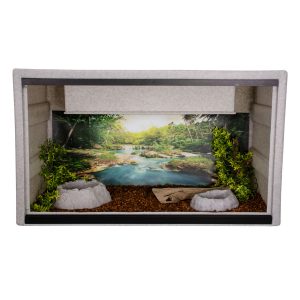 Model 433 Cage$889.00
Model 433 Cage$889.00 -
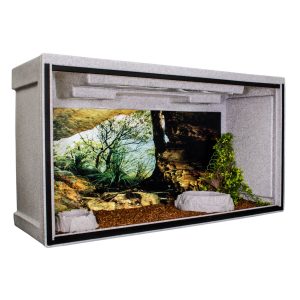 Model 734 Cage$2,249.00
Model 734 Cage$2,249.00
Enclosure Temperature and Lighting
Create a temperature gradient to replicate your prehensile tail skink’s natural habitat. This helps your cold-blooded buddy regulate its internal temperature, whether too hot or too cold.
- Cool Area: 75°-80°
- Hot Area: 85°-95°
- Ambient Nighttime Temp: 75°
Our enclosures are well-ventilated and allow the addition of heating attachments. To reach and maintain the optimal temperature, consider using a 1000-watt thermostat and probe.
You also need UVA and UVB light inside the enclosure. A full-spectrum light fixture will be your pet’s best friend because these rays are integral to a skink’s physical and mental health.
Humidity For Prehensile Tailed Skinks
For most species, maintain an internal humidity between 70-90%. Track it by placing a humidity gauge in the center of your animal’s enclosure.
Is humidity dropping below 70%? Increase the level by misting inside twice per day (once in the morning and once at night). We also offer substrates and automatic misters to help you maintain the required humidity.
More Info: Maintaining Humidity in a Reptile Enclosure
Bedding and Substrate
Most prehensile tailed skinks need a bark-based substrate. We offer mold-resistant Repti Bark that holds and releases moisture to maintain humidity. It also allows for burrowing, another common activity for this skink.
Monitor your substrate, as it may need to be cleaned frequently. Spot clean feces from the enclosure daily, but you shouldn’t have to replace the substrate for a few months.
-
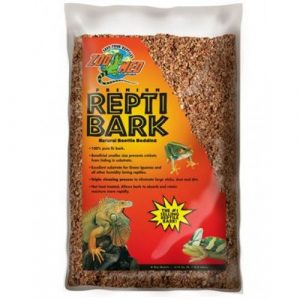 Reptile Bark$12.95
Reptile Bark$12.95
Enclosure Decor and Accessories
Don’t forget about the decor!
Include some tree branches and elevated surfaces for exercise and exploration. A prehensile tail skink will not feel at home if it’s unable to climb.
For the ground level, include at least one form of a hide. Even though prehensile tails enjoy resting in trees, a ground-level hide is essential. If your skink feels stressed, it may look for solace in a darker, cooler, hiding spot on the ground.
We also offer food and water bowls, made of the same durable HDPE as our enclosure shells.
-
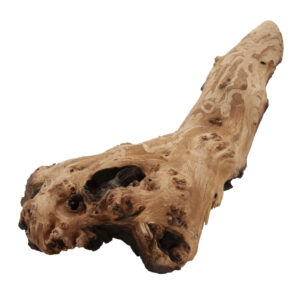 Mopani Wood$7.99 – $9.99
Mopani Wood$7.99 – $9.99 -
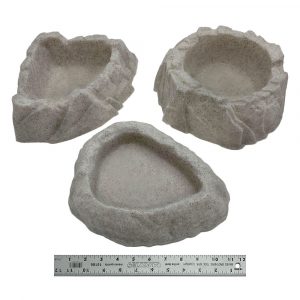 Assorted Large Reptile Bowl$29.95
Assorted Large Reptile Bowl$29.95 -
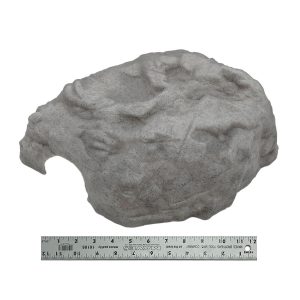 Large Reptile Cave Hide$49.95
Large Reptile Cave Hide$49.95
Find Your Prehensile Tailed Skink’s New Home
Vision Cages come in various sizes so handlers can offer their pet the most comfortable home. See which enclosure suits you and your scaly friend the best!
